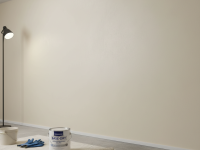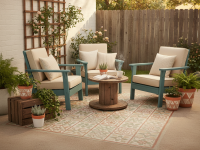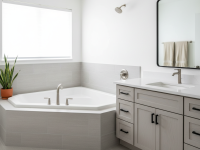Ever dreamed of a home that feels like a permanent vacation? A sanctuary that’s breezy, functional, and deeply coected to nature, even if it’s on the smaller side? Welcome to the wonderful world of small tropical minimalist homes! It’s a design philosophy that marries the serene, uncluttered principles of minimalism with the vibrant, calming essence of tropical living. And trust me, it’s not just for exotic locales; these tips can bring that relaxed, airy vibe to any compact space.
I know what you might be thinking: “Small space? Tropical? Minimalist? How do I fit all that without it feeling cramped or cluttered?” Well, that’s exactly what we’re going to explore today. From my own experience navigating compact living and my passion for creating serene environments, I’ve gathered some invaluable insights. This isn’t just about aesthetics; it’s about creating a highly functional, beautiful, and peaceful haven that truly feels like your personal paradise. So, let’s dive in and unlock the secrets to designing your dream small tropical minimalist home.
Embrace Nature’s Palette: Colors that Calm and Expand
When designing a small tropical minimalist home, your color scheme is perhaps the most powerful tool you have. Think about the colors you see iature, especially in tropical environments: soft sands, clear skies, lush foliage, and bright ocean blues. These are your friends!
- The Foundation: Neutrals are Your Canvas. Start with a base of crisp whites, soft off-whites, or very light greys for your walls. These colors reflect light beautifully, making small spaces feel larger and airier. They also provide a calm backdrop, allowing your carefully chosen tropical accents to pop without overwhelming the space.
- Layers of Green and Blue: Introduce greens from plants (more on that later!) and various shades of blue through textiles like cushions, throws, or a piece of art. These colors bring the outside in and evoke a sense of calm and freshness. Imagine a subtle turquoise cushion or a deep jungle green throw – instant tropical vibe without visual clutter.
- Pops of Earthy Warmth: Don’t forget the warmth! Natural wood tones, rattan, bamboo, or even a hint of terracotta can add depth and an organic feel. These aren’t bright, overwhelming colors, but rather grounded, earthy tones that complement the minimalist aesthetic and tropical theme beautifully. I’ve found that a light teak coffee table or a woven seagrass rug can instantly add warmth and character.
The Power of Light and Air: Your Home’s Natural Architects
In a small tropical home, natural light and good ventilation aren’t just luxuries; they are fundamental design elements. They literally breathe life into your space and coect you to the environment outside.
- Maximize Natural Light: This is non-negotiable. Use sheer, lightweight curtains or blinds that can be easily pulled back to let in as much sunlight as possible. Avoid heavy drapes that block light and make a room feel smaller. Strategically placed mirrors can also work wonders, reflecting light and creating the illusion of more space. One trick I often use is placing a large mirror opposite a window to amplify both light and views.
- Embrace Cross-Ventilation: Tropical climates can be warm and humid, so air circulation is key. If possible, design your layout to allow for cross-ventilation. Think about where your windows and doors are located to create a natural breeze flow. If architectural changes aren’t an option, invest in good ceiling fans, which are both functional and can add a stylish tropical touch. Open windows and doors whenever possible to let the fresh air circulate – it’s invigorating!
Smart Furniture, Smarter Living: Every Piece Earns Its Keep
Minimalism, especially in small spaces, demands that every item serve a purpose. This is where smart furniture choices come into play. Forget bulky, ornate pieces; think sleek, multi-functional, and appropriately scaled.
- Multi-Functional Marvels: A coffee table with hidden storage, an ottoman that doubles as extra seating, a sofa bed for guests – these are your best friends. I once lived in a tiny studio where my dining table folded down from the wall! Every inch counted, and multi-purpose items were lifesavers.
- Scaled-Down and Leggy: Opt for furniture that is proportionate to your room size. Overstuffed sofas or huge armchairs will swallow up a small space. Choose pieces with slender legs or open bases; this allows light to pass underneath and creates a sense of opeess, making the room feel less cluttered and visually lighter.
- Vertical Storage is Your Superpower: When floor space is limited, look up! Wall-mounted shelves, tall, narrow bookcases, and built-in units are excellent for storage without encroaching on your living area. Keep shelves uncluttered to maintain the minimalist aesthetic – display only a few meaningful items.
Bring the Outdoors In (Thoughtfully!): Your Indoor Jungle Oasis
What’s a tropical home without a touch of greenery? Integrating plants is essential, but in a minimalist context, it’s about quality over quantity.
- Choose Wisely: Opt for a few larger, striking tropical plants rather than many small ones. A towering Snake Plant, a majestic Fiddle Leaf Fig, or a sprawling Monstera can make a statement without creating clutter. These also help purify the air, which is a big bonus!
- Natural Materials: Complement your plants with natural materials. Think woven rattan chairs, a bamboo room divider, or a jute rug. These textures add warmth and organic beauty, grounding your space iature. Avoid anything synthetic or overly glossy; aim for authentic, breathable materials.
- Subtle Water Features: If space allows, a tiny tabletop water feature can add a wonderfully soothing element, bringing the sound of a tropical cascade into your home. Ensure it’s perfectly scaled for your space and easy to maintain.
Decluttering is Your Superpower: The Heart of Minimalism
This might seem obvious, but it’s the absolute cornerstone of a small minimalist home. You simply caot achieve that serene, airy tropical feel if your space is overflowing with stuff.
- Ruthless Editing: Be honest with yourself about what you truly need and use. My rule of thumb? If I haven’t used it in six months (excluding seasonal items), it’s probably time to let it go. Embrace the “one in, one out” rule – for every new item you bring into your home, one old item must leave.
- Hidden Storage, Organized Life: Utilize closed storage solutions as much as possible. Baskets, storage boxes, and furniture with drawers are your allies. Keeping everyday items neatly tucked away maintains the clean lines and visual calm that minimalist design thrives on.
- Curated Displays: Instead of having many small trinkets, choose a few meaningful pieces for display. This could be a unique shell found on a beach, a piece of local art, or a beautiful ceramic vase. Less is definitely more here.
Texture Over Pattern: Adding Depth Without Overwhelm
In a small minimalist home, busy patterns can quickly make a room feel chaotic and cramped. Instead of relying on bold prints, use texture to add interest and sophistication.
- Layered Textures: Think about combining different natural textures: a soft linen sofa, chunky knit throws, woven placemats, smooth wooden surfaces, and perhaps a sisal rug. Each texture adds a layer of visual and tactile interest without adding visual noise.
- Natural Fabrics: Stick to natural fabrics like cotton, linen, hemp, and jute. They are breathable, have a beautiful hand, and fit perfectly with both the tropical and minimalist aesthetics. These materials often have a lovely subtle texture themselves.
Illumination for Ambiance: Beyond Natural Light
Even with ample natural light during the day, your small tropical minimalist home needs thoughtful artificial lighting to create a warm and inviting atmosphere in the evenings.
- Warm Tones are Key: Opt for light bulbs with a warm color temperature (around 2700K-3000K). This creates a cozy, inviting glow that mimics natural sunset light, rather than harsh, cold light that can feel sterile.
- Layered Lighting: Don’t rely on a single overhead light. Incorporate ambient lighting (like a central ceiling fixture), task lighting (a reading lamp by your favorite chair), and accent lighting (to highlight a plant or piece of art). Floor lamps with natural material shades (like rattan or rice paper) can add a beautiful tropical touch.
Conclusion: Your Personal Oasis Awaits
Designing a small tropical minimalist home is truly an exercise in intentional living. It’s about prioritizing comfort, functionality, and a deep coection to nature, all while keeping your space serene and uncluttered. By carefully selecting your colors, maximizing light and air, choosing smart furniture, thoughtfully incorporating greenery, and committing to decluttering, you can transform even the smallest space into a breathtakingly beautiful, highly functional, and wonderfully calming sanctuary.
Remember, your home should be a reflection of you – a place where you can relax, recharge, and feel utterly at peace. So, take these tips, infuse them with your own personality, and start creating that tiny tropical paradise you’ve always dreamed of. Happy designing!




